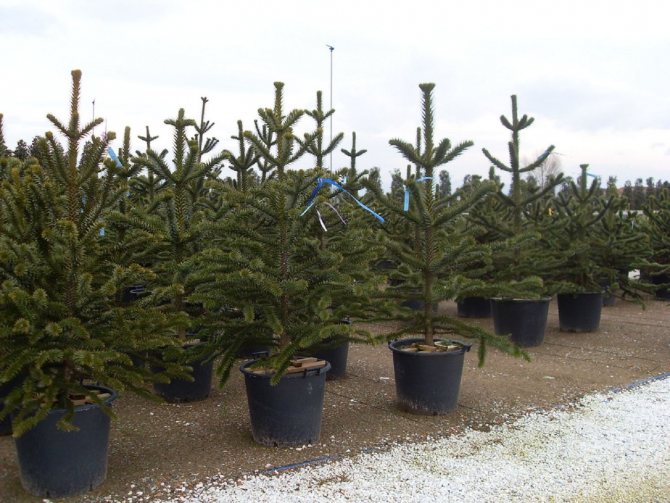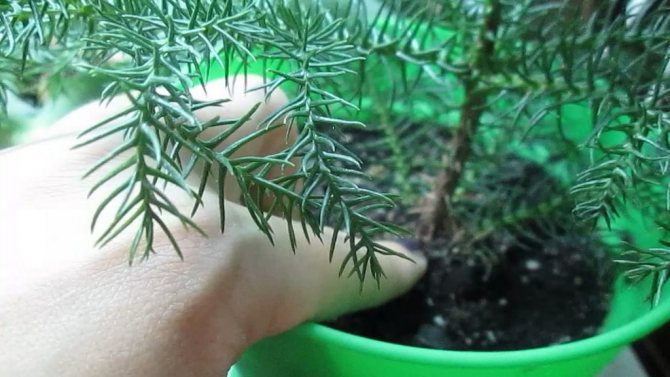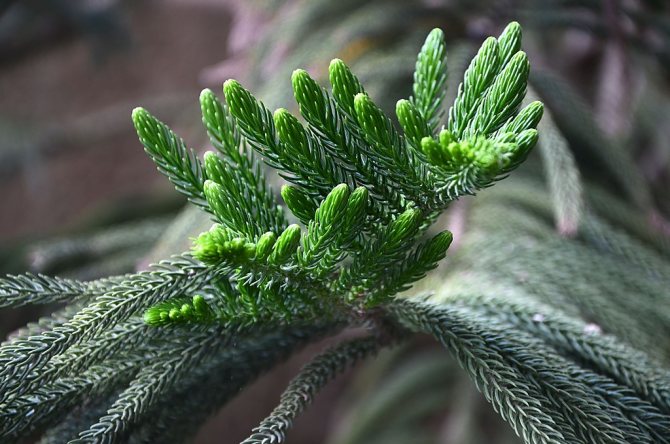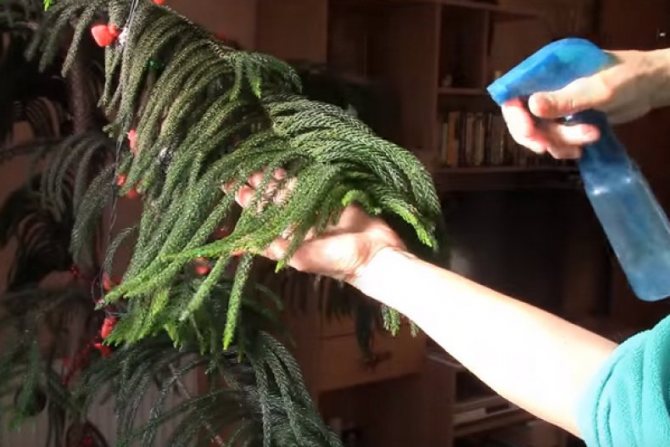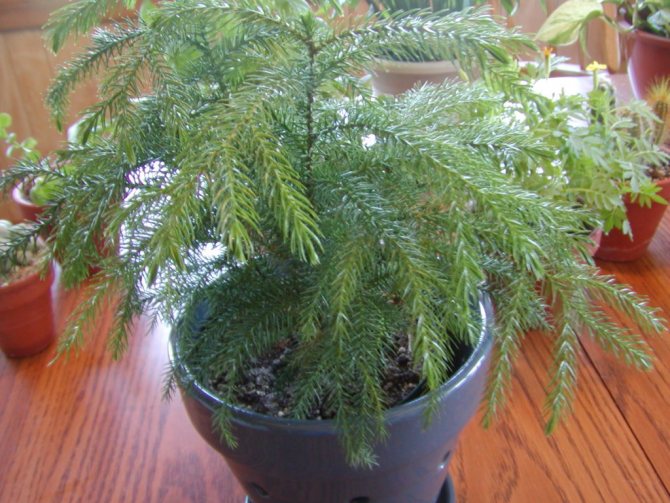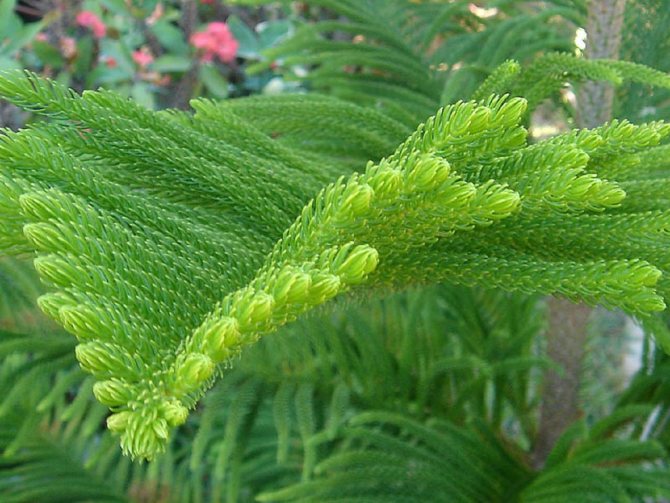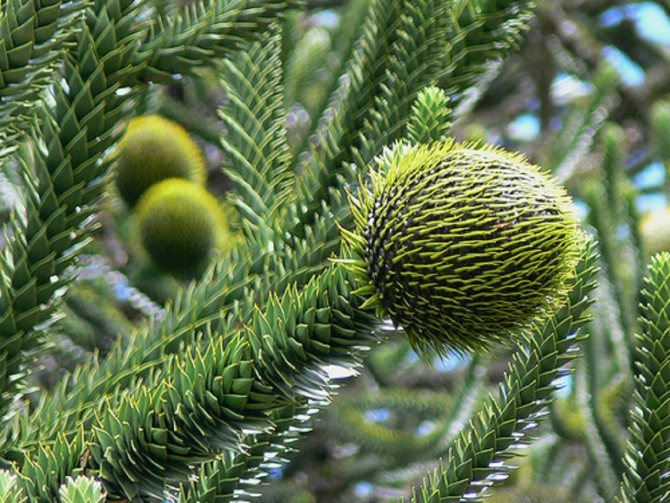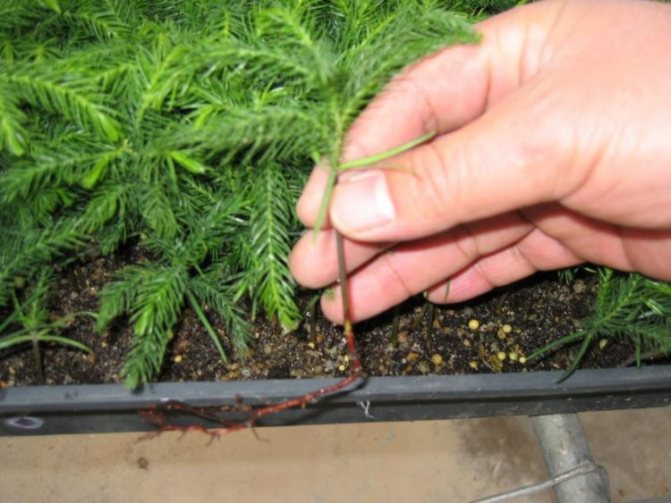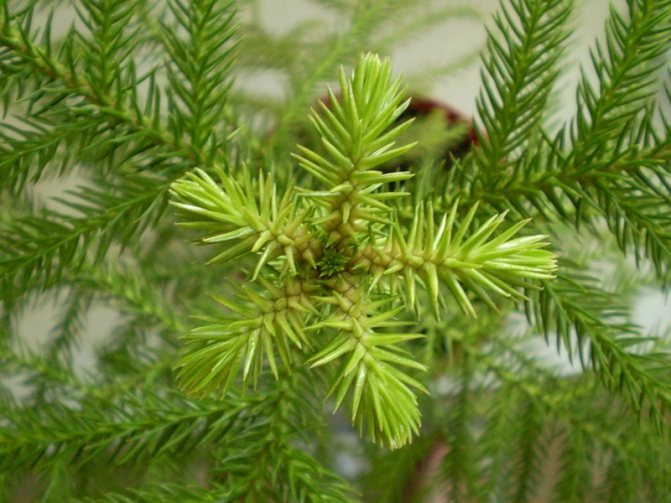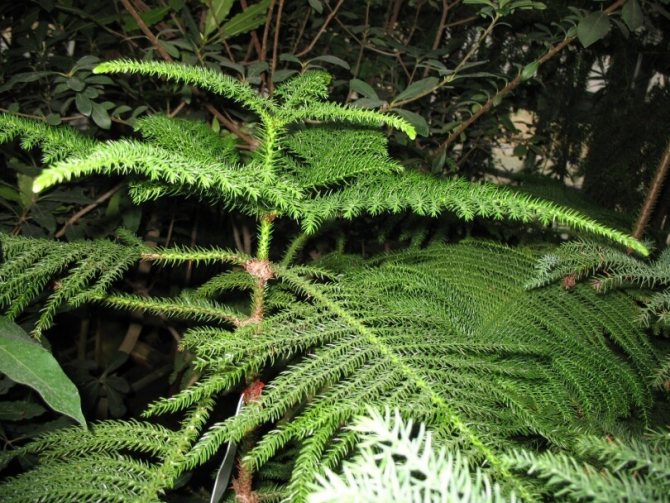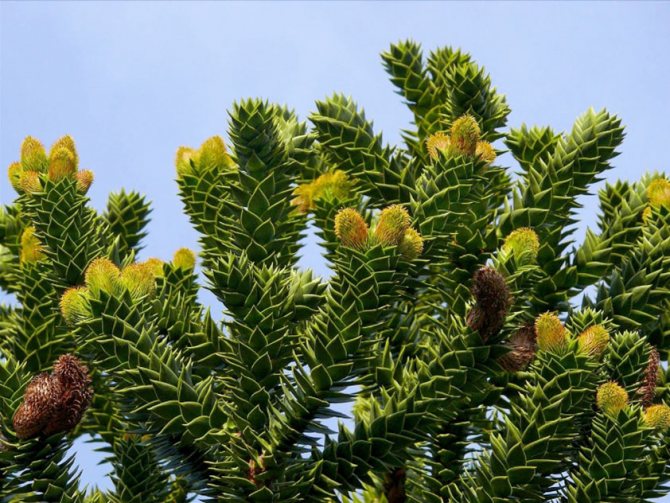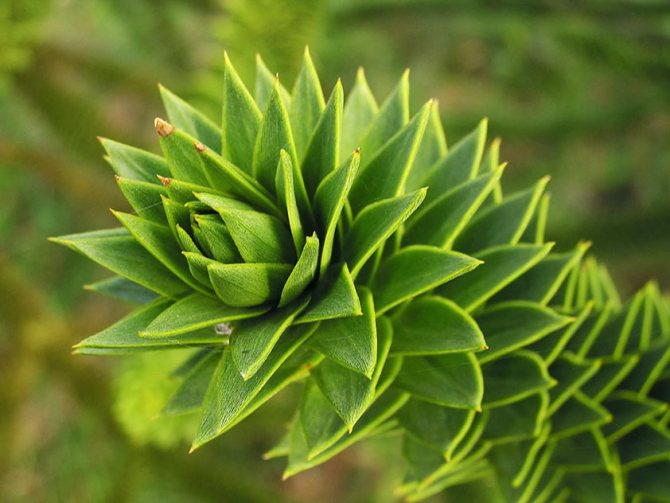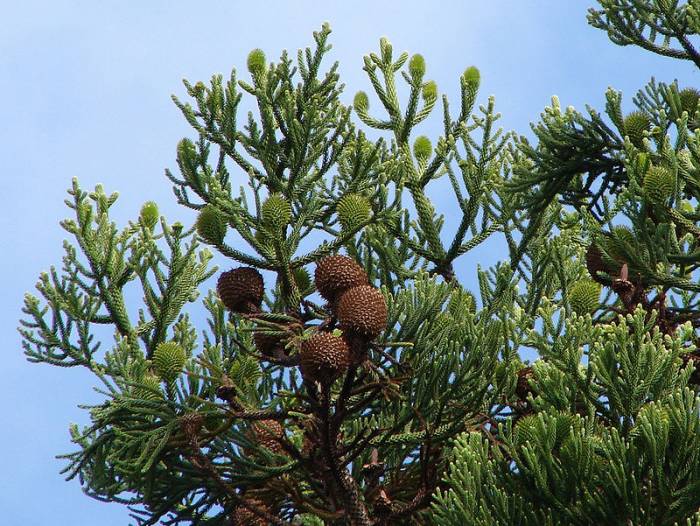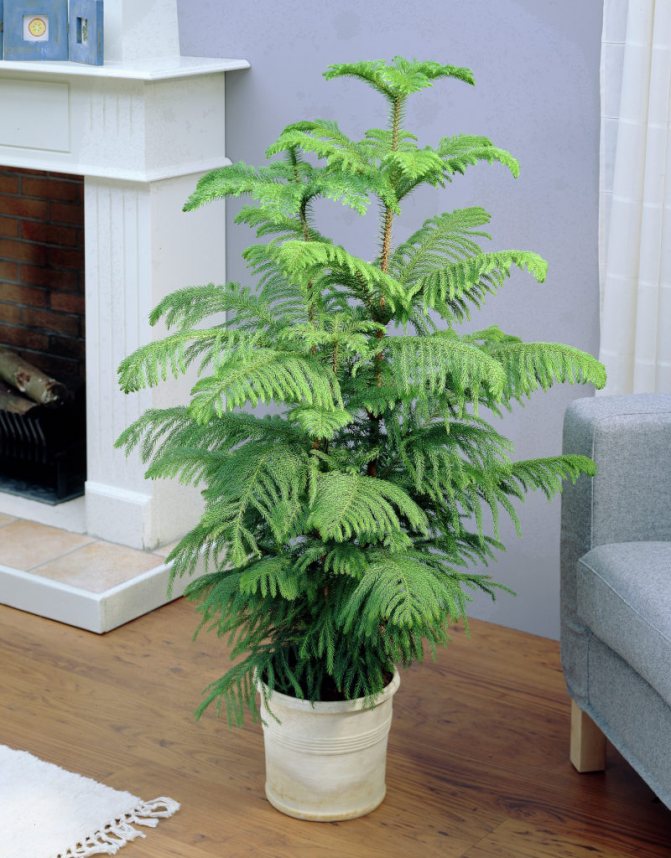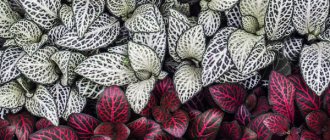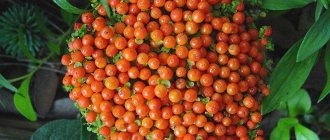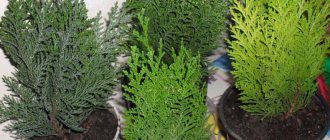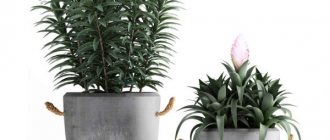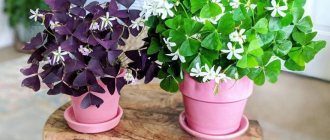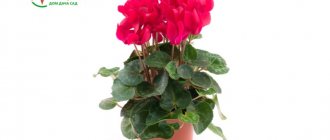Araucaria is a small tree with graceful twigs and needles, bright green in color and unusual shape. In the natural environment, there are more than 20 species of this family, most of which are huge trees, but there are also cultivated varieties. Araucaria grows up to 2 meters tall with proper care and is suitable for home decoration.
Such a spruce is a perennial plant that loves fresh air, moderate watering and high humidity. It has a high resistance to attacks from various pests and is not susceptible to typical diseases of indoor flowers, but it is demanding on the regime of feeding and transplanting, and also does not tolerate dry air and an incorrectly chosen growing place.
Description
Araucaria is a coniferous evergreen plant from the Araucariaceae family. In its natural environment, it grows to a gigantic size (up to 50–80 m in height) and is a long-liver. Pine, or Chilean araucaria is the second name of the tree. The Mapuchi Indian people consider it sacred, and also eat cones.
The tree has an upright trunk with branches extending at right angles. Indoor araucaria cannot be higher than two meters. The branches are whorled and, when viewed from above, resemble the outlines of a star. The shoots are completely covered with tough needles of a rich green color with a bluish bloom. Sizes of needles: length - up to 5 mm, width - from 0.2 to 2 mm.
The appearance of the plant is as follows:
- Straight trunk, branches relative to it are located at a natural right angle.
- The foliage represented by the needles varies in shade - from light green in the cases of variegated araucaria, and to rich dark green in the Chilean or Brazilian araucaria.
- The leaf plates are located close to each other, the structure is rigid.
- The bark of the plant is scaly, rather highly resinous.
- The crown of the araucaria is pyramidal, in some species it is domed.
- The cones are relatively small, about 20 cm, in the case of males the plants are elongated, and in the female araucaria they are rounded.
Araucaria is a rather tall tree, there are species up to 100 meters high. The trunk is straight with a thick resinous bark. Coniferous leaves are flat and very tough, spiraling on the branches.
The tree belongs to dioecious: male cones are elongated, and female cones are round.
Araucaria belongs to the Araucariaceae family, a genus of evergreens. The homeland of the tree is considered to be the states of the Southern Hemisphere:
- Australia;
- South America;
- New Guinea;
- New Zealand.
Correct lighting
It is known that, in nature, the branches of the trees on the north side are less long and dense. To grow a harmonious araucaria tree, it is required to organize uniform double-sided lighting. If this is not possible, the pot with the plant is turned 90 ° weekly. In winter, daylight hours are artificially extended.
At home, araucaria grows on forest edges, far from other trees. In the house, it also requires a separate space. Araucaria does not tolerate direct sunlight. A coniferous plant can thrive in partial shade with sufficient daylight hours. In the summer, a pot with a Christmas tree is taken out to a closed loggia or to a garden under the shade of trees.
Types of Aruacaria
In total, there are 19 plant species belonging to the Araucariaceae family. For the most part, these are tall trees with flat needles. Some species are considered decorative, they are bred to decorate streets in the Caucasus and Crimea.
Araucaria varifolia (indoor fir) Araucaria heterophilla Is the most popular human cultivated plant from the Araucariaceae genus. It was brought from Norfolk Island. In the wild, it reaches 60 m in height, indoors it will gain height very slowly and will not grow more than 1.5 m. Thanks to its branches and foliage, the araucaria is called a “home tree”.
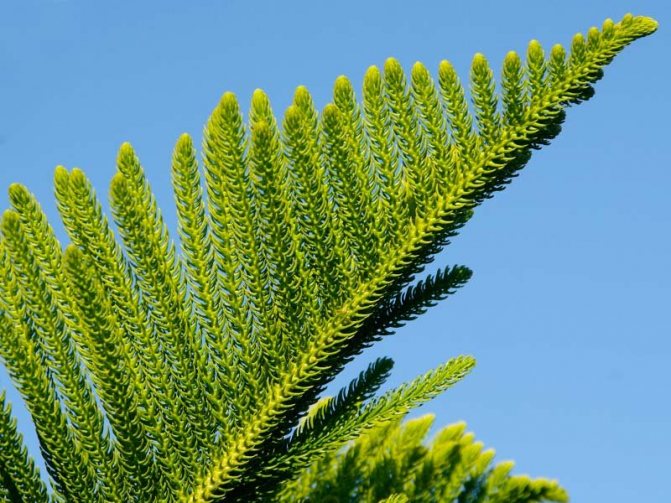
It has a brownish peeling bark, a crown that grows in the form of a pyramid, gathering from rigid branches with small greenish leaves-needles 2 cm long. On the tree trunk, branches grow whorled, densely, forming a kind of spiral. Small short (no more than 8 cm) scales appear on young branches of the branches.
Araucaria brasiliana (Brazilian araucaria) and Araucaria angustifolia (narrow-leaved araucaria) can become houseplants. Despite the fact that wild specimens have a height of about 50 m, at home they will grow no more than 3 m. Thin branches are densely covered with short emerald leaves of a triangular shape.
Tree view Araucaria araucana (araucaria chilean) is found in Chile and western Argentina. This plant grows in natural conditions up to 60 m with a trunk diameter of about 1.5 m. The crown looks like a wide pyramid. The lower branches fall to the ground, and over time they die off and fall off. The branches grow strictly horizontally, and quite bifurcated.
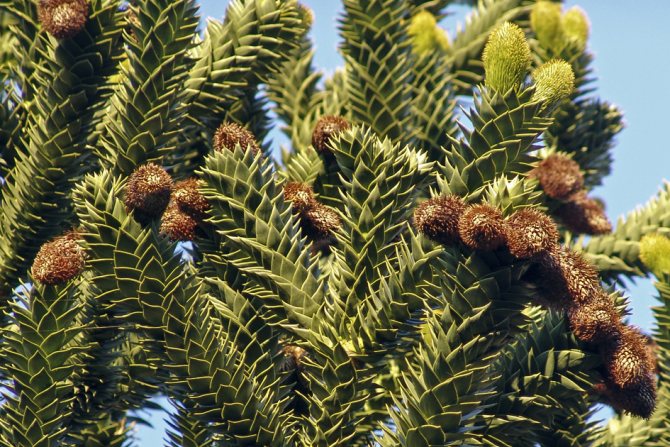

They are slightly "drooping" in older trees and are all densely covered with rigid greenish triangles that resemble a monkey's tail. The culture loves good light, high air humidity, sufficiently humid (not marshy) and nutrient-rich soil. It easily tolerates droughts and light frosts. The large seed of the plant is eaten, it is tasty and nutritious.
Araucaria bidwillii (Bidwilla). Grows in the east of Australia. In natural conditions, it grows in height up to 50m. Leaves are glossy thorny.
Araucaria Chilean, like Araucaria Bidvilla, are very large trees, reaching (female specimens) a height of 60 m with a trunk diameter of up to 1.5 m. The crown of young trees is wide-pyramidal, and its lower branches lie directly on the ground. Lower branches usually fall off with age. The lateral branches of mature trees are located 6-7 in whorls, they are horizontally elongated or hang slightly in old trees, the crown becomes flat-umbrella-shaped, located only at the very top of the trunk. The bark is resinous, thick, longitudinally fissured.
The growth of young plants (up to 30-150 years of age) can reach 45 cm per year, and then decreases to 10-15 cm. In this, araucaria sharply differ from the extremely slowly growing agatis.
The leaves of the Chilean araucaria are tough, thorny, dark green, spirally arranged, cover the branches very tightly to each other. The leaves are 2.5-4 cm long, 1.5-2.5 cm wide, they are ovoid in shape with a pointed tip, attached to the shoot with a wide base. Leaves live up to 40 years.
A characteristic feature of the Chilean araucaria is its microstrobila. They are axillary, solitary (but very often come together in groups at the very top of the branch, 2-4-6), straight, cylindrical, sometimes almost oval, surrounded by vegetative leaves at the base.
Cones on short lateral branches, the vegetative leaves of which gradually turn into the scales of the cones. Mature cones are brown, spherical, with a diameter of 12-18 cm (they reach a mass of 1.6 kg), at first they are covered with long, elongated up to 3 cm and upward curved edges of the covering scales, which subsequently break off.
Mature trees produce 20-30 cones, each of which contains up to 200-300 large seeds. When ripe, the cone crumbles. Mature seeds are oblong, slightly compressed, 2.5-4 cm long; narrow borders and remnants of a wing are noticeable along the edges of the seeds.
Problems
- Prolonged heat leads to drooping branches, yellowing of needles, slowing growth, weakening of the plant;
- Excessive dryness of the air can lead to yellowing of the needles. and to their premature shedding.If, in this case, spraying of the plant is not resumed, the araucaria may even lose the branches left without foliage. It has about the same effect on the "home tree" and insufficient watering;
- Hard water with a high content of calcium salts, used for irrigation or spraying, causes a decrease in the growth of araucaria. A whitish bloom may appear on its needles;
- With a lack of nutrients, young twigs become thin and pale.
Home care for Aruacaria
Lighting and temperature
Before buying a homemade spruce, you need to know how to care for araucaria. It is important to create the necessary illumination.
Araucaria needs sunlight for normal development, but direct rays are not at all useful. Therefore, it is better to keep the plant in the west or east window. For uniform growth and development, the tree needs to be turned towards the light with one or the other side after about 5-7 days.
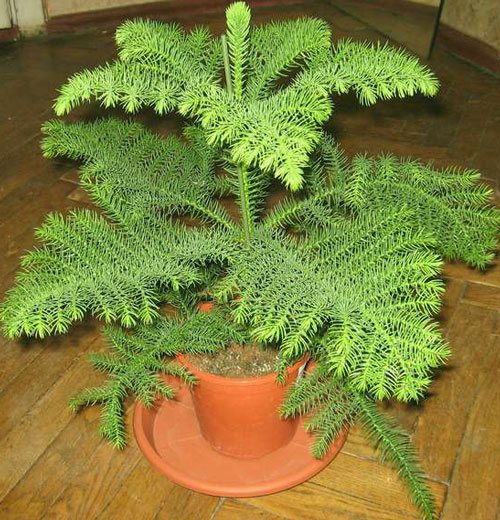

Araucaria is contraindicated in heat! In summer, the temperature of the content should not exceed 20 degrees, in winter 10-15 degrees will be optimal.
In summer, the araucaria plant can be kept outside, always protecting it from the sun and precipitation. At home, the supply of fresh air is provided by frequent ventilation of the room.
Before you start growing araucaria at home, you need to choose the conditions in which it will have to grow. They should be as close as possible to the natural habitat of the plant. At home, culture grows in the open air high in the mountains, where it is constantly cool. Therefore, it does not tolerate warm rooms, the ideal temperature is 10 ... 20 ° C. It's a little cooler in winter.
Air humidity: the higher the temperature, the higher the humidity should be. Araucaria indoor decorative tree prefers humid air of the environment. When the room is too dry, the plant may shed its leaves. To increase the humidity, you can spray the needles with water or even arrange a sometimes warm shower. You can place a flowerpot with a tree near the aquarium, or use a tray with wet small stones.
Watering
Caring for indoor araucaria involves warm, abundant watering. You need to use only softened water. The watering liquid can be boiled and cooled or allowed to settle. You can also use well-filtered tap water. In general, watering should be organized according to this scheme.


In the summer, you need to irrigate a lot, just maintain a moderate moisture content of the substrate: that is, the cooler it is in the room, the less you need to water. The next time, watering is done after the soil has dried by ¼. Water should not stagnate in the pan, excess liquid from the pan is poured out after 30 minutes. It is also important to spray needle foliage on summer days. In winter, the plant is watered less often, about once every 2-3 days.
Watering requires soft, settled water at room temperature. You can use rain or boiled. Watering should be regular, the soil should not be allowed to dry out and waterlogged. In winter, it is cut, especially when the tree is kept in cool conditions.
If watering should be moderate, then the air humidity is maintained high enough, otherwise the side branches will begin to dry out. To create optimal conditions, the tree is constantly sprayed, at least once a day, both in summer and in winter.
Succinic acid and epin can be added to the spray water.
In addition, the plant can be placed in a pallet filled with pebbles or expanded clay, constantly keeping them wet. The soil in the pot can be overlaid with moss, constantly moistening it.
Top dressing
Top dressing in summer - every 2 weeks, in winter - apply fertilizer every 6 weeks. In this case, the solution should be made weak.From mid-spring to mid-autumn, such events should become regular, otherwise the needles will turn pale and become thin. It is important that calcium is applied to a minimum, an excess of it will slow down the growth of the culture.
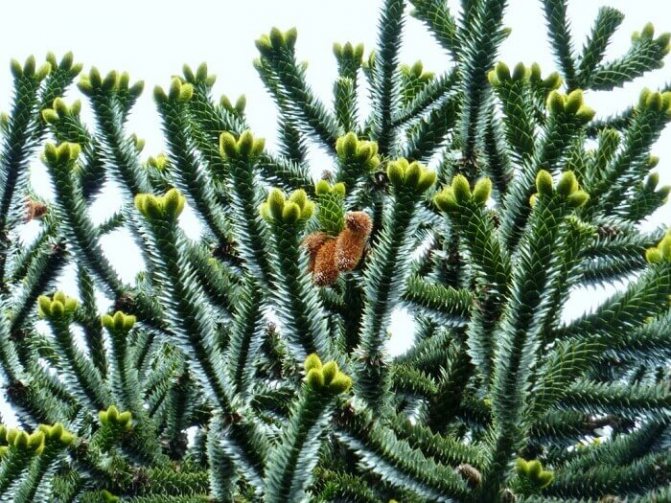

For growing indoor araucaria, you can choose one of the types of substrate:
- Flower potting soil with 1/3 sand or leaf humus with 1/3 sand and 1/3 loam.
- From a mixture of turf, deciduous and peat soil with sand (in a ratio of 1: 2: 2: 1).
- From the combined loam, soddy-leaf soil and sand (in a ratio of 2: 1: 0.5).
- From turf, deciduous soil, humus, peat and sand (in equal proportions) with the addition of ½ share of the earth from needles.
- Ready-made commercial soil mixture "For conifers".
It should be remembered that the culture loves a slightly acidic substrate.
Transplant and reproduction
The tree does not really like transplants, so it does not need annual replants. The plant should be transplanted if it "grew" from its pot. That is, no more than once every 2-3 years.
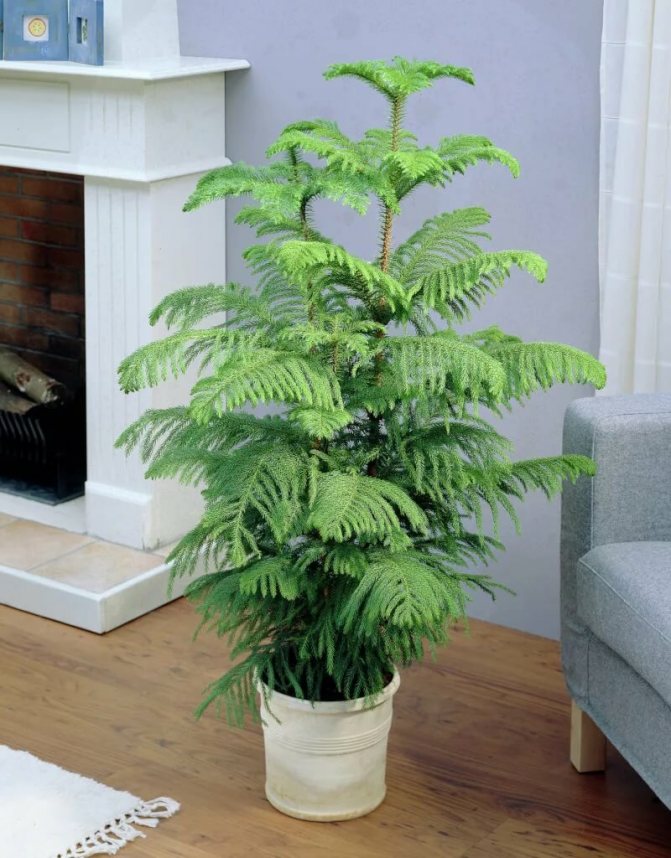

At the bottom of the container, they make good drainage from expanded clay, pebbles, in order to prevent stagnation of water. Soil for araucaria is made from a mixture:
- sheet (1 part);
- turf (2 parts);
- peat (1 part);
- sand (2 parts).
Another option - in equal shares:
- deciduous land;
- coniferous;
- sod soil;
- peat;
- sand;
- humus.
The houseplant araucaria can also be grown hydroponically.
For planting araucaria, you should use a special substrate designed for conifers. When self-preparing the soil, its composition should include such components as peat, sand, leaf and sod land. A prerequisite for a successful planting is filling a third of the pot with drainage.
Advice!
Don't go for large, spacious spruce pots. Otherwise, it will quickly grow into a full-fledged tree and will not be indoor decorative greenery.
You can grow araucaria on your own from seeds or using the upper cuttings of adult plants. The process of seed descent is not always successful, but a simple algorithm of actions is suitable for propagation by cuttings:
- Cut off one of the upper cuttings of the tree and put it in a cool place for a day.
- Remove the resin from the cuttings and treat them with charcoal.
- Plant such a sprout in sand mixed with peat and cover on top with a transparent glass container.
- Choose a bright and warm place for the pot.
Provided that the air temperature is within 25, the rooting process will end in 2 months, and when new needles appear, the young plant can be transplanted into the substrate, where it will continue to develop.
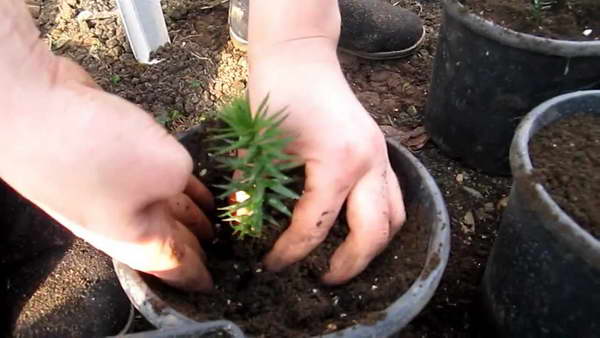

Landing
Annual transplanting is inappropriate, it is enough to transplant the tree every few years, while in order to restrain growth, a pot of about the same size is chosen as it was, and the composition of the soil is updated and the root system is cleaned. For transplanting, the method of transferring a previously well-moistened plant to a new pot is well suited.
Araucaria transplant is carried out with great care. It is better to replace it with transshipment so as not to damage the roots. This must be done at least once every 4 to 5 years. Young "herringbones" are rolled into larger pots more often as they grow. Damage to the root system is very dangerous for the plant. Sometimes, during transplantation, the integrity of the bark is disrupted.
Then the tree “cries”. The hardened resin flows down the trunk. When transplanting (transshipment), it is important not to fill up the root collar. It is very dangerous. I add new potting soil every year, carefully removing some soil from the top layer. The soil mixture should have a slightly acidic reaction. It can be composed of coniferous soil (or rotted needles from the forest), peat, turf and sand.
The list of "whims" of the variegated araucaria is not as long as they often write about it. The plant has a large margin of safety. But do not forget that in nature it lives in completely different conditions.It is impossible to recreate them, but we can pay more attention to the araucaria. This beauty does not forgive negligence towards herself.
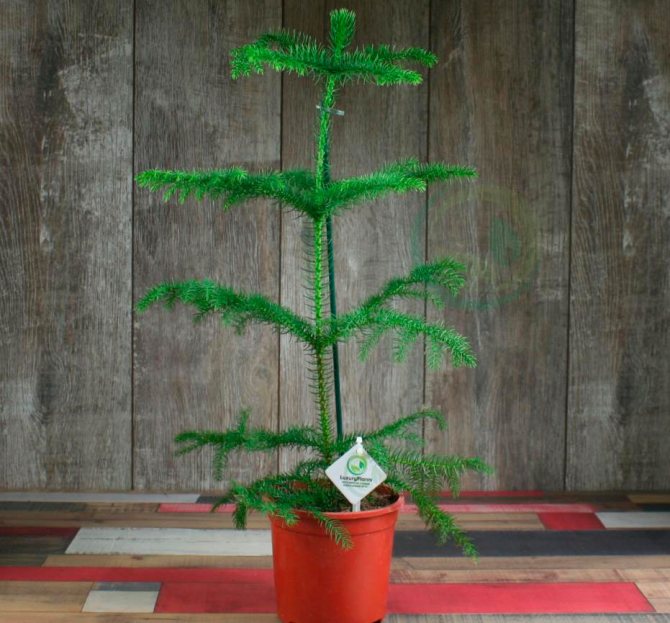

The plant is transplanted in early spring as needed - as soon as the roots fill the entire volume of the pot, the ephedra is simply transferred into a more spacious container.
In order not to disturb the already mature trees, the old layer of soil in the pots is removed, and a new layer of soil rich in nutrients is filled in instead. After transplanting, the plants need high humidity, so the pots are placed indoors without ventilation and are often sprayed.
Seeds are sown in early spring. They are germinated in a mixture of peat and sand and covered with wet sphagnum moss on top. They are kept at a temperature of 18-20 ° C. Crops are watered very rarely and in moderation.
Diseases and pests
"Araucaria" is rarely affected by pests, but sometimes it does.
Araucaria is a fairly resistant plant and rarely gets sick from various diseases and the effects of parasites. Deterioration in appearance is mainly associated with inappropriate conditions of detention and inappropriate care. The following insects pose the greatest danger to culture:
- aphid;
- pine loach;
- motley moth;
- mealybug.
When affected by them, powdery formations appear on the needles. It is necessary to remove them with a cotton pad moistened with alcohol, and then spray with an insecticidal preparation "Aktara" or soapy water.
To smooth out the problems that have arisen, it is required to eliminate provoking factors. With good care, indoor spruce pleases with its lush crown and fills the air with coniferous aroma all year round.
| Pests / Diseases | Control methods | Fight | Prevention |
| Aphid | The leaves show punctures from insect bites, as they feed on the juice of Araucaria. | Spray with insecticides: Actellik, Intavir. | You can put Pelargonium next to it, its phytoncides will scare away insects, aphids can be washed off with water. |
| Mealybug | The flower withers, the branches droop. | Wash off insects with soapy water. | |
| Spider mite | The plant turns yellow and withers, cobwebs are visible on the leaves. | Rinse the plant under the shower, wipe the leaves with soapy water. | |
| Chlorosis | Young shoots lose the color saturation of the leaves, adults turn yellow. | Place the araucaria in a draft-free area, increase the room temperature, and water as soon as the soil dries. Apply fertilizer. | Avoid wind and waterlogged soil. |
Araucaria is not particularly susceptible to disease.
But take a look: situations such as in the photo with the image of the home araucaria may arise when:
- Leaves fall off (if the air or soil is too dry).
- The needles turn yellow and fall off (with increased heat conditions and dry air).
- The trunk is pulled out, the foliage turns pale (when there is not enough light).
- Aphids, mealybugs appear.
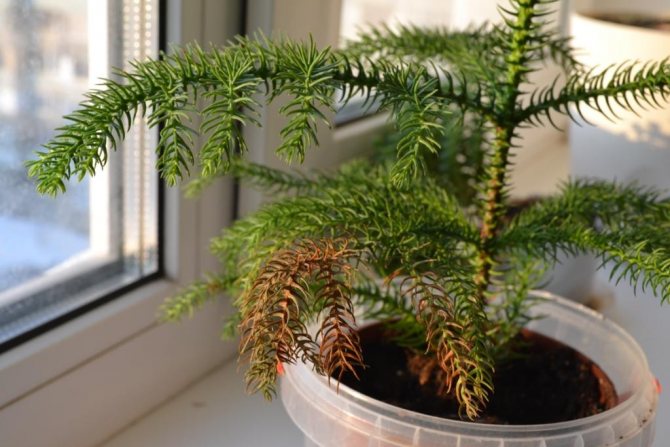

To eliminate such problems, it is necessary to exclude the factors that provoke them, and if damaged by pests, treat it with soapy water or special means.
The consequences of violating the rules of plant care leads to possible symptoms.
- The plant grows poorly - with an excess of calcium. The tree must be transplanted into suitable soil, watered with softened water, and the fertilizer changed.
- Very thin new twigs - appear when there is a lack of nutrients. Increase the amount of dressings, change the land.
- Barrel curvature - uneven lighting. Turn the container with the plant 90 degrees every week.
- Shoots turn yellow and dry out - with insufficient air humidity. Increase the number of sprays, place the pot in a pan with water.
- The needles dry and fall off - the reason may be both low air humidity and insufficient watering.
Araucaria Chilean is affected by aphids. Soap solutions are suitable to combat the pest. 300 grams of laundry soap is diluted in 10 liters of cold water.The resulting mixture is sprayed with needles until the pest disappears completely.
Pine can be affected by mealybugs. To eliminate it, it is necessary to spray the plant with the preparations "Vertimek", "Tsvetofos" or "Fitoverm" with an interval of seven days until the complete disappearance of the pest.
Why do the branches of araucaria dry and what to do
The main sign of improper tree care is the condition of its crown and branches. If they turn yellow and dry, then the plant has been attacked by pests or sick.
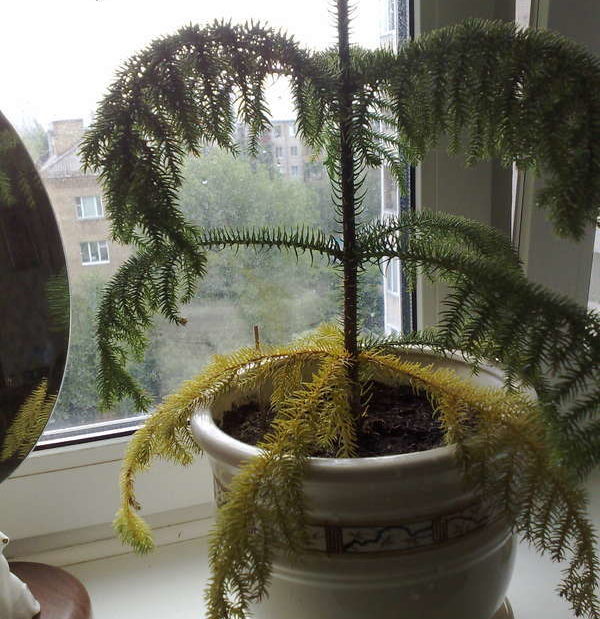

Yellowing of branches
Pests and methods of control
Compared to other ornamental greens, araucaria is very rarely attacked by insects that can damage it, but such cases do happen. The tree may be damaged by such pests:
- Mealybug - a sign of its appearance will be white lumps on the branches of a tree. In order to destroy the pest, you can use spraying with a solution of alcohol, laundry soap and water, and also treat the tree with special poisons at least three times with an interval of 10 days.
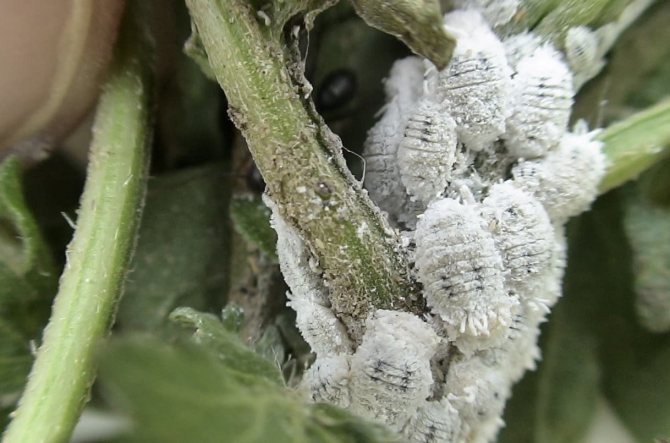

Mealybug - Root beetle - its appearance is evidenced by the dried lower branches of the spruce. In order to get rid of the pest, you need to treat the soil with an insecticide solution.
- Aphids appear on the crown of a tree in the form of pineal growths, which grow rather quickly and the plant dries up. For disposal, insecticides are well suited, for example Mospilan, Calypso.
- The speckled moth leads to the death of the tops of the cuttings, and the plant acquires the brown color of the branches. It is necessary to treat the tree twice with special agents containing pyrethroids, the interval between such measures is 7-8 days.
- Pine loach can be noticed by the abnormal curvature of the shoots and the drying of young twigs. It is imperative to remove the affected parts of the spruce and treat with special chemicals.
When a pest is recognized at an early stage of its development on spruce, the process of extermination is much easier, and the appearance of the greenery eventually quickly returns to normal.
Diseases and treatment
Improper plant care can lead to the development of diseases. Araucaria is characterized by the following types of diseases:
- drying and yellowing of the shoots is associated with a lack of moisture, you should bathe the flower more often;
- a curvature of the trunk indicates incorrect lighting. It is necessary to change the place of growth of the tree or turn it over more often;
- growth retardation occurs with an excess of potassium.
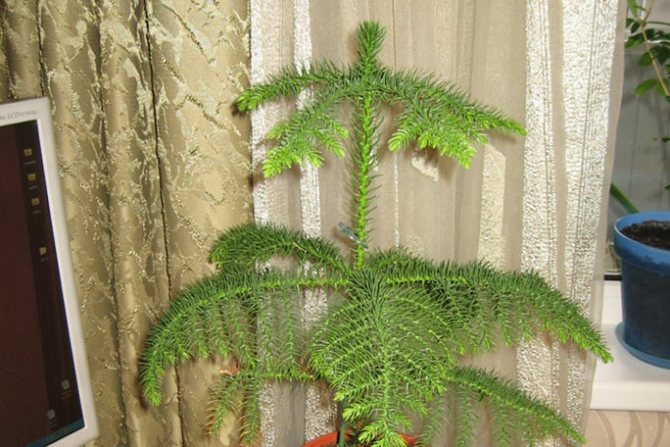

It is not recommended to use hard water and the composition of the feed should be checked. - drooping branches indicate excess moisture. Reduce the amount of water used when wetting the soil;
- thin and sluggish young shoots indicate that the greenery lacks nutrients. You should increase the amount of top dressing or change the fertilizer to a better one.
Indoor spruce has a high resistance to various diseases of ornamental greenery, but nevertheless, improperly organized care can harm the plant.
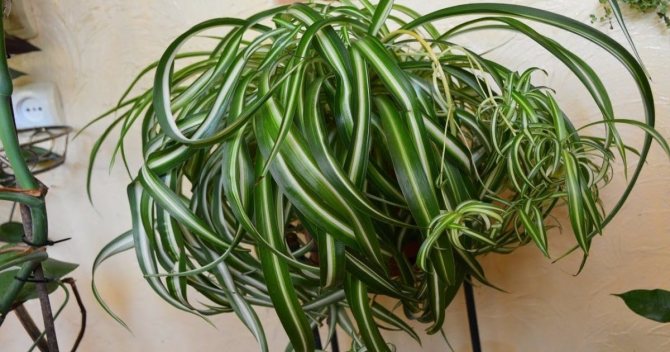

You may be interested in:
Chlorophytum Curly - home care and reproduction Novice flower growers want to find ornamental plants that are useful and easy to care for in everyday life. Excellent ... Read more ...
Common mistakes in care and their elimination
| Errors | The reasons | Elimination |
| Shoots are thin. | Low in nutrients. | During the period of active growth, feed with fertilizers. |
| Leaves fall off, dry and turn yellow. |
|
|
| The branches wilted. |
|
|
| The tree does not grow. | Too much fertilizer and calcium in the top dressing. | Transplant the plant into new soil and choose a different top dressing. |
| The plant died. |
| Avoid these factors. |
| The needles are blackened, the branches are drying up. | The root system is damaged. |
|
Reproduction
Araucaria can be propagated in two ways.
Cuttings
For cuttings, half-lignified upper shoots are needed. In early spring, make a cut a couple of centimeters below the whorl. Place the cutting in a dark place for a day. Remove the resin from the cut and sprinkle with charcoal. Treat the stalk with a growth stimulant (Kornevin). Plant in a pot filled with a peat-sand mixture. Cover with a jar on top. Place the landing in a warm place. Regularly remove and ventilate the shelter. The rooting process takes several months. When the rooted cutting gets stronger, transplant it into a substrate suitable for adult plants.
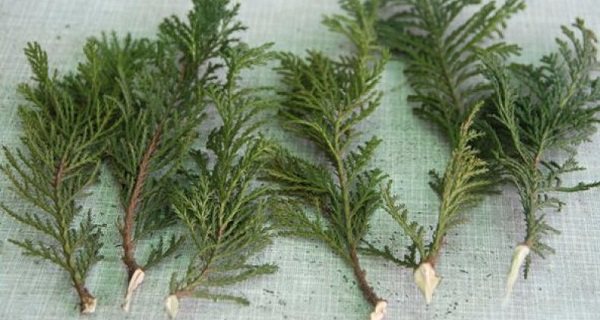

Seeds
Only fresh seeds germinate well. They are immediately sown in separate containers with a mixture of peat, sand, turf, leafy soil. Take all components in equal parts. Add some ash. Water the crops with water, cover with sphagnum on top. Periodically moisten them with a spray bottle and ventilate. It is better to germinate seeds at a temperature of +20 degrees.
The seeds do not sprout at the same time. After several true leaves appear on the seedlings, they are dived into separate pots without injuring the root system.


Helpful information
- Do not forget that the top of the spruce is its growth point. If you damage the top, the tree will stop growing upward and an ugly crown will begin to develop.
- If you constantly keep the ephedra at too high a temperature, then it will begin to lower the branches and shed the needles.
- Too low humidity in the room can lead to drying out of needles and even shoots. The plant can also get sick due to insufficient watering.
- If the ate does not have enough nutrients, then the shoots will begin to thin out and the tree will look weakened.
- Indoor araucaria is a plant that does not like calcium. Due to the excess of calcium in the dressings, indoor spruce can stop growing.
If you properly care for the araucaria and create favorable conditions for it, then the indoor spruce can grow into a very decorative and majestic tree, which is good for decorating the interior of large rooms. Growing araucaria and caring for it at home is pretty simple.
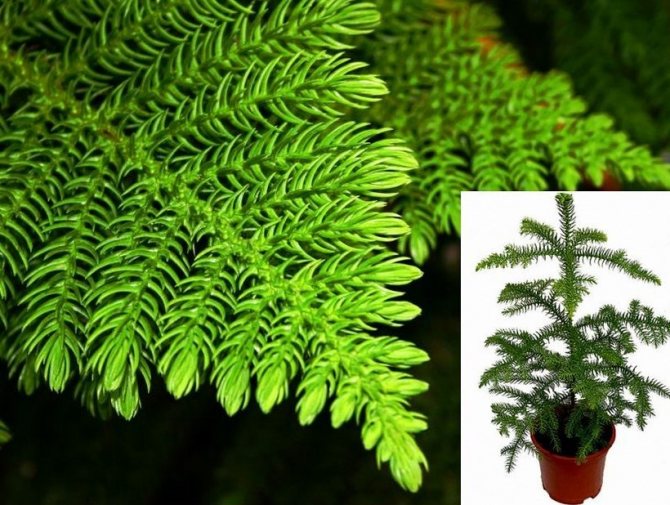

Caring for "home spruce" does not require excessive efforts from the grower, but certain manipulations should be performed to maintain the normal life of the coniferous tree.
The plant has powerful energy. It can awaken creativity, provoke people to be active. Moreover, the action is both positive and negative. Araucaria enhances the energy in the house, no matter what it is. There is a sign that the plant in the house activates the protective properties, gives peace and tranquility to those living in it.
The beneficial property of spruce is that it moisturizes and purifies the air. People with hypertension should not keep it in the house. And for those who have low blood pressure, on the contrary, it is necessary, but you cannot put it in a relaxation room.
After viewing the above material, there will be no questions about how exactly the crop you like should be grown. And let the homemade spruce make you happy every day!
Transfer
Araucaria tolerates transplants very painfully, so they need to be carried out only if the roots are completely entwined with an earthen lump. The indoor spruce is carefully removed from the pot and trying not to disturb the rhizome. The new pot should be deep and wide enough. A large drainage material is laid out at the bottom. The soil for araucaria usually consists of:
- sod soil;
- river sand;
- sheet soil;
- peat.
If desired, you can add coniferous soil and deciduous humus to the substrate.After transplanting, the plant is left alone for several days. It is not recommended to over-wet the soil, turn and move the tree.
